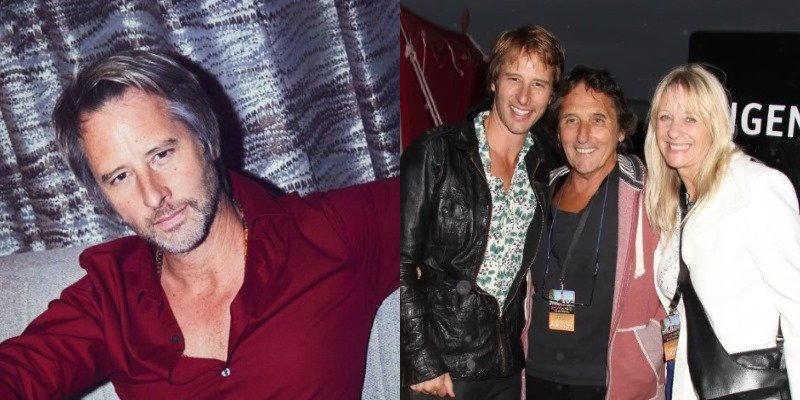Chesney Hawkes, who was born into a world of spotlights and amplifiers, was destined for something louder than everyday life. His early years were spent in an incredibly cinematic environment, more akin to a backstage lounge humming with musical instruments, famous visitors, and the unceasing hum of creativity than a home. His father, Chip Hawkes, the bassist for the Tremeloes, and his mother, Carol Dilworth, a former actress and game-show hostess whose charisma once lit up British living rooms, both had a significant influence on the rhythm of his childhood despite their careers being rooted in the 1960s.

Growing up in this high-octane home, Chesney was exposed to storytelling, performance, and perseverance almost by osmosis. In addition to being his guardians, he remembers his parents as artists whose identities were anchored in glitz and rhythm. They served as the foundation and the screenwriters for his life story, not as supporting characters. He recalls afternoons when rehearsals used the living room as a makeshift stage and parties that lasted until dawn. He once told The Guardian, “Our house was party central,” a statement that still echoes warmly from a particularly vivid childhood decades later.
| Category | Details |
|---|---|
| Full Name | Chesney Lee Hawkes |
| Date of Birth | 22 September 1971 |
| Birthplace | Windsor, Berkshire, England |
| Father | Len “Chip” Hawkes – Bassist of The Tremeloes |
| Mother | Carol Dilworth – Actress and Game Show Host |
| Siblings | Keely Hawkes (singer-songwriter), Jodie Hawkes (drummer) |
| Career Start | 1990 – Film “Buddy’s Song” and single “The One and Only” |
| Top Hit | “The One and Only” – UK No. 1 for five weeks |
| Spouse | Kristina Hawkes (married 1997) |
| Children | Casey, Jesse, Indi |
| Website | chesneyhawkes.com |
The Tremeloes: Establishing a Tradition That Would Last for Many Generations
Chip Hawkes had a significant influence on music. With songs like “Here Comes My Baby” and “Even the Bad Times Are Good,” he and the Tremeloes contributed to the development of the British beat group sound in the late 1950s and early 1960s. Rich guitar textures and lively lyrics were harmonized by the band’s contagious energy, transforming each song into a joyful time capsule. Chip was contributing to the definition of a musical era in addition to playing bass. A certain cultural weight comes with that kind of success, and it remarkably permeated his kids’ artistic endeavors.
Carol Dilworth’s flair was remarkably different. In addition to co-hosting The Golden Shot, a program that demanded extraordinary on-screen agility, she appeared on screen in cult favorites like The Haunted House of Horror. Her ability to transition between live hosting and scripted drama demonstrated an extraordinarily broad range of skills. For her children, particularly Chesney, this meant having a mother figure who made art feel grounded rather than elusive by fusing professionalism and performance.
When Celebrity Becomes a Family Tradition: Showbiz in the Blood
Inheriting artistic talent across showbiz lineages is frequently more about presence than pressure. This particularly applies to Chesney’s siblings. Prior to embarking on a prosperous songwriting career in Los Angeles, Keely Hawkes rose to fame in the 1990s as the vocalist for the band Transister. Jodie Hawkes eventually joined their father’s resurrected Tremeloes lineup after taking up the drumsticks and going on stage with his brother. The pattern, in which talent is not duplicated but rather reincarnated in new forms, is remarkably similar to that observed among the Jacksons or the Beckhams.
In remarkably inspired ways, Chesney’s own children are carrying on this tradition. After graduating from The BRIT School, his son Indi now plays lead guitar on his tours. When Chesney talks about seeing his son tearing up riffs with casual brilliance while looking across the stage, his voice becomes proud. In a 2024 interview on Lorraine, he acknowledged, “He’s way better than I ever was.” This admission, which is equal parts celebration and humility, paints a poignant picture of generational talent that has been reimagined rather than recycled.
Cultural Undercurrent: In a Changing Industry, From Glamour to Grit
The Hawkes family’s story reflects more general changes in the entertainment sector. Celebrity felt dazzling and untouchable in the 1960s and 1970s. However, legacy artists now have to negotiate a digital landscape where craft is frequently eclipsed by virality. Chesney’s journey is especially inventive because he has consistently changed who he is, whether it is by participating in reality shows like The Games or entering the musical theater industry. This versatility, which is also evident in celebrities like Will Young and Kylie Minogue, has been incredibly successful in maintaining public favor.
Tour buses, national TV slots, and record sales were the foundation of Carol and Chip’s era. Artists of today struggle with audience fragmentation and algorithmic visibility. The Hawkes legacy hasn’t been diminished, though. It has been subtly redefined instead. The family provides a very clear example of how to age in entertainment without becoming outdated through performances that combine nostalgia with fresh vitality.
Why the Hawkes Story Is Still Relevant, Particularly Today
The upbringing of Chesney Hawkes reads less like a fairy tale and more like a case study in emotional richness and resilience in a time when authenticity is a cultural obsession. He didn’t just take his parents’ fame; instead, he mirrored their rhythms, absorbed their grit, and used that to build his own fan base. He is creating a new legacy loop by incorporating his kids into his performances, which feels especially advantageous for his career and the devotion of his fans.
Families like the Hawkes, where passion and skill are passed down through the generations like priceless vinyl records, have an indisputable reassuring quality. They serve as a reminder that regardless of how the industry changes, artistry can endure forever if it is nourished by love and driven by progress. You remember that rhythm. And it’s still very evident in Chesney’s case.
